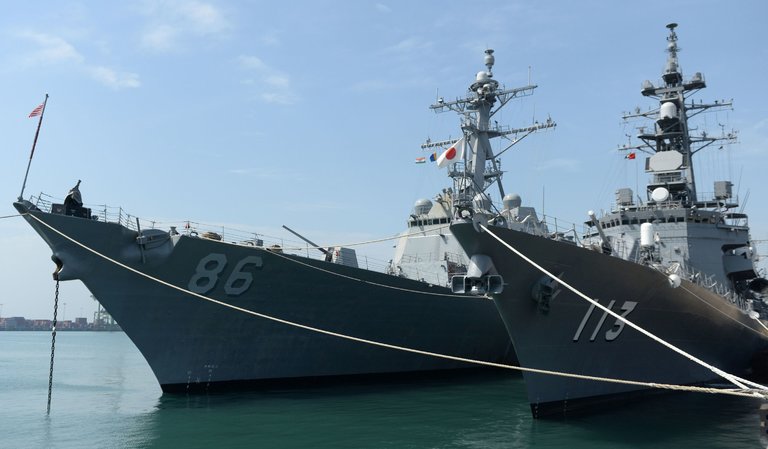
American and Japanese ships during the inauguration of joint naval exercises with India on Monday in Chennai, India. CreditArun Sankar/Agence France-Presse — Getty Images
NEW DELHI — The navies of India, Japan and the United States began a set of war games on Monday with a particular target: submarines capable of sliding unannounced into the deep waters of the Indian Ocean, silently taking positions near the Indian coastline.
It is not a mystery whose submarines are at issue. Last month, the Indian Navy announced a plan to permanently station warships to monitor movement through the Strait of Malacca, where many Chinese vessels enter from the South China Sea. And in recent weeks, navy officials here have reported a “surge” of Chinese military vessels entering the Indian Ocean.
Routine maritime exercises have long served as a gauge of India’s uneasy relationship with China, prompting a shrug or a blast of condemnation, depending on the circumstances.
The annual series of naval exercises, known as the Malabar series, began in 1992. This year’s event was the largest to date, and the first to feature carriers from all three navies. The games are unfolding under tense circumstances, nearly a month into an aggressive standoff between Chinese and Indian border forces in the Himalayas.
On Sunday, the Chinese Embassy in New Delhi took the unusual step of warning its citizens to be especially cautious traveling in India for the next month.
Against that backdrop, the influx of Chinese warships into the Indian Ocean is another indicator of Beijing’s displeasure, said retired Adm. Anup Singh, who has overseen the exercises in the past.
“They are deliberately upping the ante in order to flag their posture to people who are concerned,” Admiral Singh said. “The Indians, the Japanese and the Americans. So they deliberately do it as a pinprick.”
Though India’s Navy is dwarfed by China’s, India holds a strategic advantage in the Andaman and Nicobar archipelago, which stretches 470 miles to the northwest of the Strait of Malacca, a “choke point” connecting the South China Sea to the Indian Ocean.
This position, which could be used to put pressure on Chinese supply lines, is an increasing focus of cooperation between India, the United States and Japan. Monday’s China Daily, an English-language government newspaper, referred apprehensively to the maritime exercises in an editorial, noting that the Indian Ocean is one of China’s main conduits for trade and oil imports.
“It is China that should feel ‘security concerns,’” it concluded.
China’s submarine fleet has expanded rapidly in recent years. The country has assumed control of Pakistan’s Gwadar Port, finalizing plans to sell eight submarines to Pakistan, and opening its first overseas military logistics supply facility in Djibouti.
For Indian leaders, who for centuries have focused on contested northern borders, this has required a sudden shift in attention to 4,700 miles of southern coastline, along which much of the country’s security and energy infrastructure is concentrated.
“This is a tectonic shift in India’s security calculus, that it has to protect its southern flank,” said Brahma Chellaney, a professor of strategic studies at the Center for Policy Research. One response, he said, would be “a concert of democracies to rein in these muscular activities.”
Both Japan and the United States have expressed eagerness to team up with India on its maritime frontier. Last month, the United States agreed to sell India 22 advanced surveillance drones, which could be deployed to the Strait of Malacca and used to track Chinese naval movements. The drones can be used in concert with the American-made P-8I Poseidon surveillance aircraft, which are already staged on the Andaman and Nicobar Islands.
The Indian government has signaled that it is willing, after many years of resistance, to expand security infrastructure on the archipelago. In May, a wildlife board approved the creation of missile testing and surveillance facilities on Rutland Island, a project first proposed in 2013.
Last year, Japan became the first foreign government allowed to build infrastructure on the archipelago — a 15-megawatt power plant. But it is eager to break ground on a range of other connectivity projects, said Darshana M. Baruah, a research analyst at Carnegie India. When Mr. Modi visited Japan last year, the two leaders agreed on a plan to develop “smart islands,” as part of a set of projects in sensitive frontier areas.
This week’s naval exercises will involve the United States’ Nimitz, a nuclear-powered aircraft carrier; India’s I.N.S. Vikramaditya, a Russian-made aircraft carrier; and Japan’s JS Izumo, a helicopter carrier, as well as 13 other warships and submarines. Japan is participating for the second year in a row. A decade ago, China was infuriated when the three countries teamed up with Australia for naval exercises, applying immediate diplomatic pressure that prompted Australia to withdraw.
This year, Australian military officials asked for their country to take part as an “observer,” but India rejected the idea.